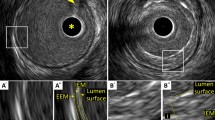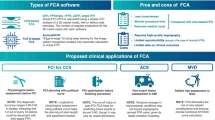Abstract
Atherosclerosis is a variable morphologic process resulting in heterogeneous plaque components and nonuniform extent and degree of plaque deposition. We and others have developed techniques of arterial imaging, segmental reconstruction and motion analysis to determine regional vascular reactivity in arterial segments having varying and expanding degrees of atherosclerosis. We have developed and validated position registration devices (PRD) for geometric three dimensional reconstruction of coronary and peripheral arteries using intravascular ultrasound. Elaborating upon an algorithm (McKay et al.), we have developed a technique using biplane cine fluoroscopy to identify intravascular ultrasound image catheter coordinates. Initial data demonstrates clinical feasibility for accurate intracoronary three-dimensional ultrasound reconstruction. For intravascular imaging across occlusions, a prototype 20 MHz forward viewing intravascular ultrasound catheter (Cardiovascular Imaging Systems, Sunnyvale, CA) which provides a two dimensional setting distal to the catheter tip, has been developed. Transcutaneous ultrasound has been used for many years to follow atheroma progression. The use of new position registration devices allows for proper orientation such that accurate three dimensional reconstruction of the carotid bifurcation and the ilio-femoral arteries can be performed. Transesophageal echocardiography is used to evaluate different arterial beds and we have shown in familial hyperlipidemic patients undergoing LDL-apheresis, plaque progression, as determined with transesophageal echocardiography, is delayed. The accurate identification of plaque components would allow for better prediction of the effects of lipid modification regimens on plaque progression. We utilized a modified intravascular frequency device for such plaque characterization. Similarly, we are performing Doppler waveform frequency, finite element stress and finite analytic flow analysis. Data obtained from the femoral arteries to determine alterations in shear stress with expanding and eccentric atheroma. Taken together, these techniques should allow for quantitative evaluation of structural and functional characteristics of the arterial wall in different vascular beds.
Similar content being viewed by others
References
Arnett EN, Isner JM, Redwood DR et al. Coronary artery narrowing in coronary heart disease: comparison of cineangiographic and necropsy findings. Ann Intern Med 1979; 91: 350–6.
Vlodaver Z et al. Correlation of the antemortem coronary arteriogram and the postmortem specimen. Circulation 1973; 47: 162–9.
McPherson DD, Hirztzka LF, Lambert WC, Brandt B, Hunt M, Kieso RA, Hite P. Delineation of the extent of coronary atherosclerosis by high-frequency epicardial echocardiography. N Engl J Med 1987; 316: 304–9.
Crawford T, Levene CI. Medial thinning in atheroma. J Path Bact 1953; 56: 19–23.
Armstrong ML et al. Structural and hemodynamic responses of peripheral arteries of macaque monkeys to atherogenic diet. Arteriosclerosis 1985; 5: 336–46.
Bond MG, Adams MR, Bullock BC. Complicating factors in evaluating coronary artery atherosclerosis. Artery 1981; 9:21–9.
Zarins CK, Weisenberg E, Kolettis G, Stankunavicius R, Glagov S. Differential enlargement of artery segments in response to enlarging atherosclerotic plaques. J Vasc Surg 1988; 7: 386–92.
Glagov S, Weisenberg E, Zarins DK, Stankunavicius R, Kolettis G. Compensatory enlargement of human atherosclerotic coronary arteries. N Engl J Med 1987; 316: 1371–5.
McPherson DD et al. Coronary arterial remodelling procedes collateral formation in obstructive coronary atherosclerosis: high frequency intraoperative epicardial echocardiographic studies. Circulation 1987;76: IV-24.
Lanza GM, Zabalgoitia-Reyes M, Frazin L, Meyers SN, Spitzzeri CL, Vonesh ML, Mehlman DJ, Talano JB, McPherson DD. Plaque and structural characteristics of the descending thoracic aorta using transesophageal echocardiography. J Am Soc Echo 1991; 4: 19–28.
White CW et al. Does visual interpretation of the coronary arteriogram predict the physiologic importance of a coronary stenosis? New Eng J Med 1984; 310: 819–824.
Yock PG, Johnson EL, David DT. Intravascular ultrasound: development and clinical potential. Am J Card Imaging 1988; 2: 185–93.
Rosenfield K, Losordo DW, Ramaswamy K, Pastore JO, Langevin RE, Razvi S, Kosowski BD, Isner JM. Three-dimensional reconstruction of human coronary and peripheral arteries form images recorded during two-dimensional intravascular ultrasound examination. Circulation 1991; 84: 1938–56.
Rosenfield K, Kaufman J, Peiczak N, Langevin RE, Razvi S, Isner JM. Real-time three-dimensional reconstruction of intravascular ultrasound images of iliac arteries. Am J Cardiol 1992; 70: 412–5.
Evans JL, Ng KH, Vonesh MJ et al. Spatially correct three-dimensional reconstruction of intracoronary ultrasound data. Circulation 1991; 84: 11–685.
MacKay S, Potel MJ, Rubin JM. Graphics methods for tracking three-dimensional heart wall motion. Computers and Biomed Res 1982; 15: 455–73.
Evans JL, Ng KH, Vonesh MJ et al. Spatially correct three-dimensional reconstruction of intracoronary ultrasound: further validation and initial patient studies. J Am Coll Cardiol 1993;21: 181A.
Evans JL, Ng KH, Vonesh MJ et al. Arterial imaging utilizing a new forward viewing intravascular ultrasound catheter: initial studies. Circulation 1994; 89: 712–717.
Ng KH, Evans JL, Vonesh MJ et al. Three-dimensional reconstruction and display of forward viewing intravascular ultrasound data. Circulation 1994; 89: 718–723.
Bond MG, Wilmoth SK, Enevold GL, Strickland HL. Detection in monitoring of asymptomatic atherosclerosis in clinical trials. Am J Med 1989; 86: 33–6.
Insull W Jr, Bond MG, Wilmoth SK, Fishel J, Herson J. Ultrasound lesions of the carotid artery and risk factors in men. In: Glagov S, Newman W, Schaffer S, (eds). Pathobiology of the Human Atherosclerotic Plaque. New York: Springer-Verlag, 1990:663–9.
Vonesh MJ, Mesh CL, Ng KH et al. Three-dimensional reconstruction of the carotid bifurcation with vascular ultrasound using a new position registration device. Circulation 1991; 84: 11–22.
Hart JP, Vonesh MJ, Durham JR et al. Three-dimensional reconstruction of the femoral artery bifurcation with noninvasive B-mode ultrasound and a new position registration device. J Vasc Tech 1993; 17: 211–6.
Kavalis DG, Chandrasekaren K, Victor MF, Ross JJ, Mintz GS. Recognition and embolic potential of intraaortic atherosclerotic debris. J Am Coll Cardiol 1991; 17: 73–8.
Herrera CJ, Frazin LJ, Dau PC et al. Atherosclerotic plaque evaluation in the descending thoracic aorta in familial hyperlipidemic patients: a transesophageal echo study. J Am Coll Cardiol 1992; 19: 279A.
Pandian NG, Nanda NC, Schwartz SL, Fan P, Cao Q-L, Sanyal R, Hsu T-L, Mumm B, Wollschlager H, Weintraub A. Three-dimensional and four-dimensional transesophageal echocardiographic imaging of the heart and aorta in humans using a computed tomographic imaging probe. Echocardiography 1992; 9: 677–87.
Barzilai B, Saffitz JE, Miller JG, Sobel BE. Quantitative ultrasonic characterization of the nature of atherosclerotic plaques in human aorta. Circ Res 1987; 60:459–63.
Picano E, Landini L, Lattanzi F et al. Time domain echo pattern evaluations from normal and atherosclerotic arterial walls: a study in vitro. Circulation 1988; 77: 654–9.
Landini L, Sarnelli R, Picano E, Salvadori M. Evaluation of frequency dependence of backscatter coefficient in normal and atherosclerotic aortic walls. Ultrasound in Med and Biol 1986; 12:397–401.
Jones JP, Chandraratna PAN, Tak T et al. Correlation of chemical components with acoustic properties in atherosclerotic plaque. Ultrasonic Imaging 1989; 11: 137–8.
Ng KH, Vonesh MJ, Garti JT, Mortales RE, Roth SI, McPherson DD. Intravascular ultrasonic characterization of atherosclerotic plaques. Circulation 1993; 88:I-502.
Ku DN, Giddens DP, Zarins CK, Glagov S. Pulsatile flow and atherosclerosis in the human carotid bifurcation. Positive correlation between plaque location and low and oscillating shear stress. Arteriosclerosis 1985; 5: 293–302.
Zarins CK, Zatina MA, Giddens DP, Ku DN, Glagov S. Shear stress regulation of artery lumen diameter in experimental atherogenesis. J Vasc Surg 1987;5: 413–20.
Lee RT, Loree HM, Stringfellow RG, Kamm RD. Finite element modeling of circumferential stress in atherosclerotic vessels: implications for intravascular ultrasound. J Am Coll Cardiol 1992; 19:300A.
Lee RT, Richardson SG, Loree HM, Grodzinsky AJ, Gharib SA, Schoen FJ, Pandian N. Prediction of mechanical properties of human atherosclerotic tissue by high-frequency intravascular ultrasound imaging. An in vitro study. Arteriosclerosis and Thrombosis 1992; 12: 1–5.
Hart JP, Vonesh MJ, Ng KH, Payne KM, Blackburn DR, McPherson DD, Yao JST, Flinn WR, Pearce WH. Alterations in shear stress magnitude and pulsatility in the diseased common femoral artery. Clin Res 1992;40.
Cole JS, Hartley CJ. The pulsed Doppler coronary artery catheter: Preleminary report of a new technique for measuring rapid changes in coronary artery flow velocity in man. Circulation 1977; 56: 18–25.
Marcus ML et al. Measurements of coronary velocity and reactive hyperemia in the coronary circulation of humans. Circ Res 1981;49:877–91.
Author information
Authors and Affiliations
Rights and permissions
About this article
Cite this article
McPherson, D.D., Vonesh, M.J. & Ng, K.H. Perspectives in vascular ultrasound imaging: tissue characterization, 3D reconstruction and vascular mechanics. Int J Cardiac Imag 11 (Suppl 2), 133–143 (1995). https://doi.org/10.1007/BF01419827
Accepted:
Issue Date:
DOI: https://doi.org/10.1007/BF01419827




